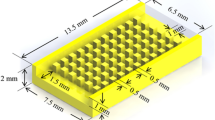Abstract
A numerical study of the effects of the thermal fluid velocity on the storage characteristics of a cylindrical latent heat energy storage system (LHESS) was conducted. Due to the low thermal conductivity of phase change materials (PCMs) used in LHESS, fins were added to the system to increase the rate of heat transfer and charging. Finite elements were used to implement the developed numerical method needed to study and solve for the phase change heat transfer (melting of PCM) encountered in a LHESS during charging. The effective heat capacity method was applied in order to account for the large amount of latent energy stored during melting of the PCM and the moving interface between the solid and liquid phases. The effects of the heat transfer fluid (HTF) velocity on the melting rate of the PCM were studied for configurations having between 0 and 18 fins. Results show that the overall heat transfer rate to the PCM increases with an increase in the HTF velocity. However, the effect of the HTF velocity was observed to be small in configurations having very few fins, owing to the large residual thermal resistance offered by the PCM. However, the effect of the HTF velocity becomes more pronounced with addition of fins; since the thermal resistance on the PCM side of the LHESS is significantly reduce by the large number of fins in the system.











Similar content being viewed by others
Abbreviations
- C p :
-
Heat capacity (J kg−1 K−1)
- E :
-
Energy (J)
- k :
-
Thermal conductivity (W m−1 K−1)
- L :
-
Latent heat of fusion (J kg−1)
- m :
-
Mass (kg)
- P :
-
Pressure (Pa)
- r :
-
Radius (m)
- r :
-
Cylindrical coordinate (m)
- T :
-
Temperature (K)
- t :
-
Time (s)
- u :
-
Thermal fluid velocity (m s−1)
- v :
-
Velocity (m s−1)
- X :
-
Solid–liquid interface position (m)
- z :
-
Cylindrical coordinate (m)
- Φ:
-
Viscous dissipation (W m−3)
- μ:
-
Dynamic viscosity (N s m−2)
- ρ:
-
Density (kg m−3)
- n :
-
Normal direction
- 0 :
-
Initial
- 1 :
-
Onset of melting
- 2 :
-
End of melting
- eff:
-
Effective
- in:
-
Inlet
- l :
-
Latent
- l :
-
Liquid
- p :
-
Pipe
- pcm:
-
Phase change material
- r :
-
In the r direction
- s :
-
Sensible
- s :
-
Solid
- T :
-
Total
- z :
-
In the z direction
References
Mehling H, Cabeza LF (2002) Heat and cold storage with PCM. Springer, Berlin
Demirel Y, Öztürk HH (2006) Thermoeconomics of seasonal latent heat storage. Int J Energy Res 30:1001–1012
Halford CK, Boehm RF (2007) Modeling of phase change material peak load shifting. Energy Build 39:298–305
Zalba B, Marin JM, Cabeza LF, Mehling H (2003) Review on thermal energy storage with phase change: materials, heat transfer analysis and applications. Appl Therm Eng 23:251–283
Sharma A, Tyagi V, Chen C, Buddhi D (2009) Review on thermal energy storage with phase change materials and applications. Renewab Sustain Energy Rev 13:318–345
Dincer I (2002) Thermal energy storage systems as a key technology in energy conversion. Int J Energy Res 26:567–588
Kurklu A (1998) Energy storage applications in greenhouses by means of phase change materials: a review. Renewab Energy 13:89–103
Bejan A (1994) Contact melting heat transfer and lubrication. Adv heat trans 24:1–38
Lacroix M (2001) Contact melting of a phase change material inside a heated parallelepedic capsule. Energy conv manag 42:35–47
Groulx D, Lacroix M (2007) Study of the effect of convection on close contact melting of high Prandtl number substances. Int J Therm Sci 46:213–220
Mills A, Farid M, Selman J, Alhallaj S (2006) Thermal conductivity enhancement of phase change materials using a graphite matrix. Appl Therm Eng 26:1652–1661
Dincer I, Sadik D (1996) A perspective on thermal energy storage systems for solar energy applications. Int J Energy Res 20:547–557
Lacroix M, Benmadda M (1998) Analysis of natural convection melting from a heated wall with vertically oriented fins. Int J Num Methods Heat Fluid Flow 8:465–478
Nayak KC, Saha SK, Srinivasan K, Dutta P (2006) A numerical model for heat sinks with phase change materials and thermal conductivity enhancers. Int J Heat Mass Transfer 49:1833–1844
Min X, Bo F, Kecheng G (2002) Preparation and performance of shape stabilized phase change thermal storage materials with high thermal conductivity. Energy Convers Manag 43:103–108
Agyenim F, Philip E, Mervyn S (2009) A comparison of heat transfer enhancement in a medium temperature thermal energy storage heat exchanger using fins. Sol Energy 83:1509–1520
Deborah AK, Michael KJ (2005) Introduction to thermal and fluid engineering. Wiley, New Jersey
Jegadheeswaran S, Sanjay DP (2009) Performance enhancement in latent heat thermal storage system: a review. Renewab Sustain Energy Rev 13:2225–2244
Lacroix M (1993) Numerical simulation of melting and resolidification of a phase change material around two cylindrical heat exchangers. Num Heat Transfer: Part A 24:143–160
Naterer GF (2003) Heat transfer in single and multiphase systems. CRC Press LLC, Boca Raton, Florida
Lamberg P (2003) Mathematical modeling and experimental investigation of melting and solidification in a finned phase change material storage. Doctoral Dissertation, Department of Mechanical Engineering, Helsinki University of Technology, Espoo, Finland
Ogoh W (2010) Numerical Study of the effects of fins and thermal fluid velocities on the storage characteristics of a cylindrical latent heat energy storage system. MASc Thesis, Dalhousie University, Halifax, Canada
Author information
Authors and Affiliations
Corresponding author
Rights and permissions
About this article
Cite this article
Ogoh, W., Groulx, D. Effects of the heat transfer fluid velocity on the storage characteristics of a cylindrical latent heat energy storage system: a numerical study. Heat Mass Transfer 48, 439–449 (2012). https://doi.org/10.1007/s00231-011-0888-3
Received:
Accepted:
Published:
Issue Date:
DOI: https://doi.org/10.1007/s00231-011-0888-3




